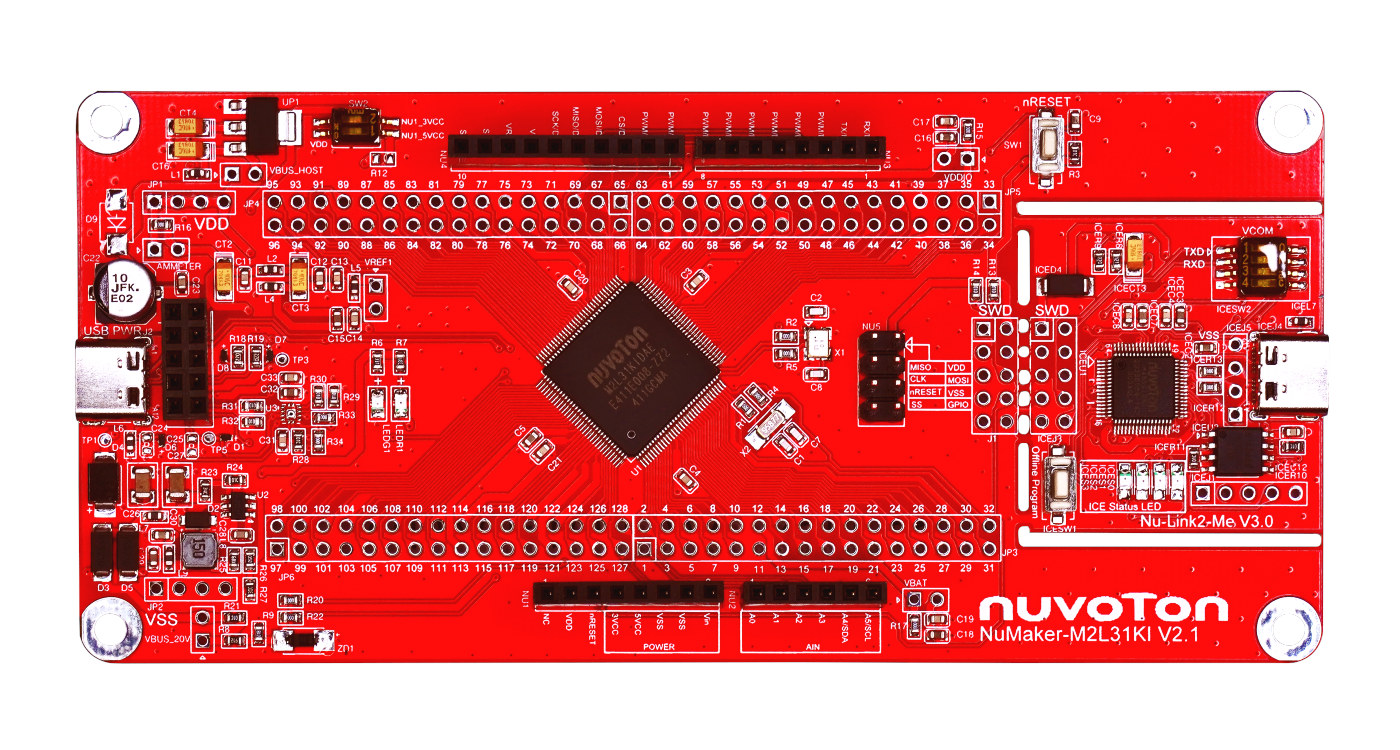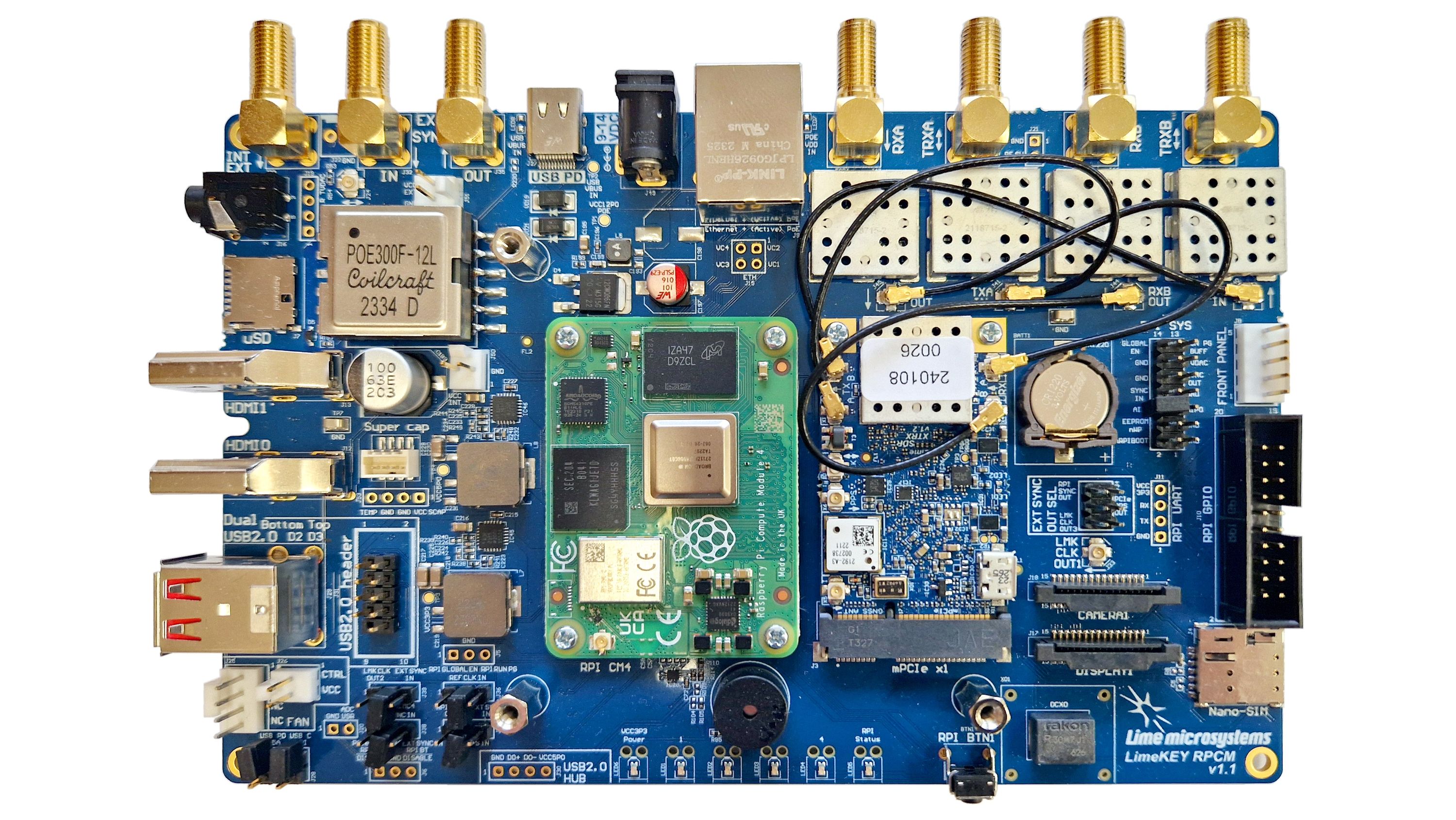Nuvoton NuMicro M2L31 is a family of Arm Cortex-M23 microcontrollers clocked up to 72 MHz, equipped with 64KB to 512KB high-durability ReRAM (Resistive Random-Access Memory) with fast write speeds, 40KB to 168KB SRAM. The microcontroller supports 1.71V to 3.6V operating voltage, can operate in the -40°C to 105°C temperature range, and offers a wide range of interfaces available through packages as small as WLCSP 25 (2.5 x 2.5 mm) and up to LQFP128 (14 x 14 mm). Arm introduced the Cortex-M23 core in 2016 together with the Arm Cortex-M33 core, but while the latter is widely integrated in a large range of designs, we’ve seen fewer Cortex-M23 microcontrollers with some examples being Microchip SAML10/L11 (2018) and more recently, the Renesas RA0 family. Nuvoton adds another option with the Numicro M2L31 that also happens to integrates ReRAM non-volatile memory. Key Features: MCU core – Arm Cortex-M23 core running up to 72 […]
$3.40 WeAct STM32WB55 board offers Bluetooth LE 5.4 and 802.15.4 (Thread/Zigbee/Matter) connectivity
WeAct STM32WB55 is an inexpensive development board based on STMicro STM32WB55 Arm Cortex-M4 wireless SoC with Bluetooth LE 5.4 and an 802.15.4 radio for Zigbee, Thread, and Matter connectivity that sells for just $3.40 shipped. STMicro STM32WB55 wireless microcontroller was introduced in 2019, and we have covered a few development boards such as the official P-Nucleo-WB55 development pack, the STM32WB-Feather board, and the MRK-SharkyPro following the Arduino MRK form factor. All those boards would go for about $40, but thanks to China manufacturing and procurement “magic” and the cutting of a few features, the WeAct STM32WB55 board sells for just a fraction of the price making it even cheaper than the company’s ESP32-H2 board with similar connectivity options. WeAct STM32WB55 specifications: Wireless MCU – STMicro STM32WB55CGU6 CPU Arm Cortex-M4 application core @ 64 MHz Arm Cortex-M0+ Bluetooth co-processor @ 32 MHz Memory – 256 KB of SRAM Storage – 1 […]
8devices Carambola 3 WiFi IoT module supports upstream OpenWrt, industrial temperature range
8devices Carambola 3 is a compact System On Module (SoM) built around the Qualcomm QCA4531 WiFi 4 chipset. The module comes in two variants – the Carambola3 for commercial applications (0 to +65°C) and the Carambola3-I for industrial environments (-40 to +85°C). Additionally, 8devices offers a development kit with integrated features like a 2.4 GHz chip antenna, dual LAN ports, USB, GPIO, and much more. Notably, the development kit also supports OpenWrt Upstream, making it ideal for IoT, industrial automation, and smart home projects. The Carambola3 is a pin-to-pin compatible module with the Carambola2, but with a faster processor, more memory, and lower power consumption while the original Carambola was discontinued due to its older technology. 8devices has been developing and selling Wi-Fi modules such as the Rambutan Atheros module, Komikan 802.11ac Wave 2 Module, and recently announced Noni M.2 WiFi 7 module feel free to check those out if […]
Autosport Labs ESP32-CAN-X2 board combines two CAN bus transceivers with automotive-grade power supply
Autosport Labs, a company that makes products for motorsport acquisition and real-time telemetry, has launched the ESP32-CAN-X2 board with an ESP32-S3 microcontroller, two CAN bus interfaces, and an automotive-grade power supply with a 6V to 20V DC input range. ESP32 boards with CAN Bus have been around for years starting with the Olimex ESP32-EVB Board which we covered in 2017, and followed by boards such as the CAN32 board, CanLite ESP32, or RejsaCAN-ESP32-S3. The ESP32-CAN-X2 adds another option with ESP32-S3 and two CAN Bus interfaces. ESP32-CAN-X2 board specifications: Wireless module – ESP32-S3-WROOM-1-N8R8 MCU – ESP32-S3 dual-core Tensilica LX7 microcontroller up to 240 MHz with 384KB ROM, 512KB SRAM, 16 KB SRAM in RTC Memory – 8MB PSRAM Storage – 8MB flash Wireless – WiFi 4 and Bluetooth LE 5 PCB antenna USB – USB Type-C port for flashing and power CAN Bus 6-pin header for 2x CAN V2.0B communication 1x […]
ESP32-S3-based kit allows you to build an Internet Radio with a touchscreen display
The ESP32 Internet Radio from Poland-based maker, The MicroMaker, is a simple hardware kit that combines the LilyGo T-Display S3 Development board with an I2S audio breakout module and other components to form a radio that can access and stream from online radio stations. With the ESP32 Internet Radio, you are not limited to the radio stations available in your immediate vicinity. It is powered by the LilyGo T-Display S3 which integrates the network-capable ESP32-S3 microcontroller (Wi-Fi + BLE 5), a 1.9” full-color capacitive touchscreen display, and two programmable buttons. The ESP32-S3’s integrated Wi-Fi capability allows the radio to connect to the Internet, and the touchscreen brings an intuitive and easy-to-use interface to the device. It supports up to 512 stored radio stations, and you can manage these stations from a web browser on your PC or mobile phone. The Internet Radio can be powered by an 18650 Lithium-ion battery […]
LimeNET Micro 2.0 Developer Edition board leverages Raspberry Pi CM4 and LimeSDR XTRX SDR module (Crowdfunding)
The LimeNET Micro 2.0 Developer Edition board is a modular software-defined radio (SDR) platform from Lime Microsystems that is based on the Raspberry Pi Compute Module 4 and the company’s own SDR board, the LimeSDR XTRX. It builds upon previous versions from Lime Microsystems, such as the LimeSDR Mini and LimeSDR Mini 2.0. It features a MIMO (multiple-input, multiple-output) radio and runs the more powerful Compute Module 4, an upgrade from the Raspberry Pi CM3 in earlier versions. The LimeSDR XTRX is an open-source, high-performance SDR in a compact, Mini PCIe form factor. It provides a platform for building logic-intensive digital and RF designs and can be used for MIMO antenna configurations from 2Tx2R to 32Tx32R. The platform is built around a planar system board, the LimePSB RPCM, which integrates the CM4, the XTRX, and other components and interfaces to make a complete baseband + RF solution for diverse wireless […]
Serial Bus Servo Driver HAT (A) can drive up to 253 servos simultaneously
Waveshare has recently introduced the Serial Bus Servo Driver HAT (A) ESP32-powered servo motor controller for the Raspberry Pi designed to drive up to 253 serial servos simultaneously. The servos can be controlled via UART or USB through the Pi SBC or used as a standalone controller for a robotics project. The board has a wide input voltage range of 9 to 25 volts and features an onboard XT60 connector, a screw terminal, and a DC barrel jack any of which can be used as power input. Besides that, the board features an RS485 port a TTL Servo header, and a UART control switch for convenience. Previously we have written about the Suptronics X200 HAT multifunction expansion board for the Pi with servo support, as well as the ELECFREAKS Wukong 2040 which can also be used to drive servos. Waveshare Serial Bus Servo Driver HAT specifications CPU – Espressif ESP32-WROOM-32 dual-core […]
The RPGA Feather dev board pairs RP2040 chip with a Lattice iCE40 FPGA for sensor fusion projects
Oak Development Technologies’ RPGA Feather board integrates the Raspberry Pi RP2040 microcontroller with the iCE5LP4K FPGA from Lattice Semiconductor into a compact development board in the Adafruit Feather form factor. The iCE5LP4K FPGA is an ultra-low-power chip in the iCE40 Ultra product family designed for mobile applications such as smartphones, tablets, and handhelds, while the Raspberry Pi RP2040 microcontroller makes it much easier to program the FPGA using CircuitPython. We have seen Oak Development Technologies’ earlier forays into FPGA Feather-compatible products such as the IcyBlue board (also based on iCE5LP4K FPGA) and the Lattice FeatherWing. RPGA Feather specifications: MCU – Raspberry Pi RP2040 dual-core Cortex-M0+ microcontroller @ 133 MHz with 264KB SRAM FPGA – Lattice Semiconductor iCE5LP4K FPGA Logic Cells – 3,520 logic cells Memory 80 Kbits of embedded Block RAM (EBR) Distributed RAM: 640 bits 2x hardware I2C blocks and 2x hardware SPI blocks 26 I/Os for customized interfaces […]










